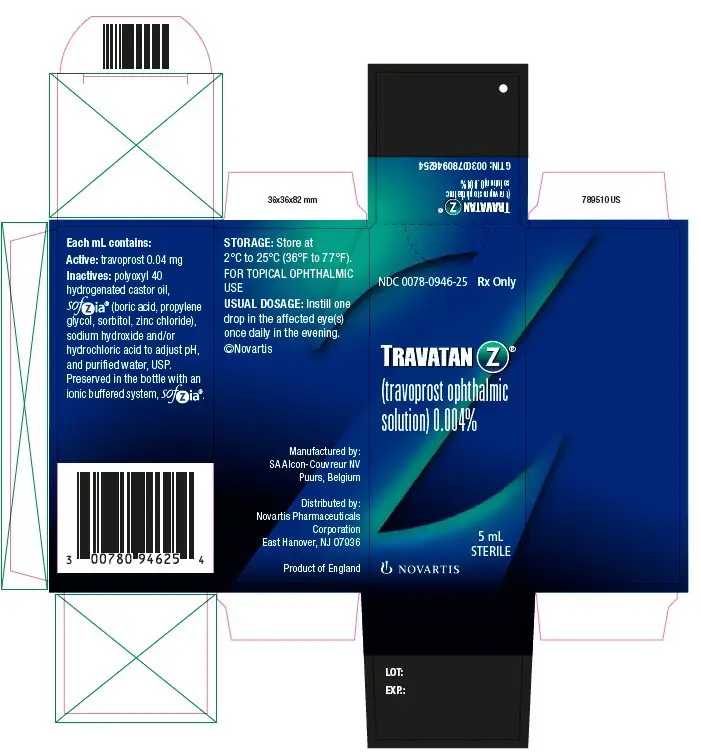Drug Detail:Travatan z (Travoprost ophthalmic [ tra-voe-prost-off-thal-mik ])
Drug Class: Ophthalmic glaucoma agents
Highlights of Prescribing Information
TRAVATAN Z® (travoprost ophthalmic solution), for topical ophthalmic use
Initial U.S. Approval: 2001
Indications and Usage for Travatan Z
TRAVATAN Z is a prostaglandin analog indicated for the reduction of elevated intraocular pressure (IOP) in patients with open-angle glaucoma or ocular hypertension (1)
Travatan Z Dosage and Administration
One drop in the affected eye(s) once daily in the evening (2)
Dosage Forms and Strengths
Ophthalmic solution containing travoprost 0.04 mg/mL (3)
Contraindications
None (4)
Warnings and Precautions
- Pigmentation: Pigmentation of the iris, periorbital tissue (eyelid), and eyelashes can occur. Iris pigmentation likely to be permanent (5.1)
- Eyelash Changes: Gradual change to eyelashes including increased length, thickness and number of lashes. Usually reversible (5.2)
Adverse Reactions/Side Effects
Most common adverse reaction (30% to 50%) is conjunctival hyperemia (6.1)
To report SUSPECTED ADVERSE REACTIONS, contact Novartis Pharmaceuticals Corporation at 1-888-669-6682 or FDA at 1-800-FDA-1088 or www.fda.gov/medwatch.
Use In Specific Populations
Use in pediatric patients below the age of 16 years is not recommended because of potential safety concerns related to increased pigmentation following long-term chronic use (8.4)
See 17 for PATIENT COUNSELING INFORMATION.
Revised: 5/2020
Full Prescribing Information
1. Indications and Usage for Travatan Z
TRAVATAN Z® (travoprost ophthalmic solution) 0.004% is indicated for the reduction of elevated intraocular pressure (IOP) in patients with open-angle glaucoma or ocular hypertension.
2. Travatan Z Dosage and Administration
The recommended dosage is one drop in the affected eye(s) once daily in the evening. TRAVATAN Z should not be administered more than once daily since it has been shown that more frequent administration of prostaglandin analogs may decrease the IOP-lowering effect.
Reduction of the IOP starts approximately 2 hours after the first administration with maximum effect reached after 12 hours.
TRAVATAN Z may be used concomitantly with other topical ophthalmic drug products to lower IOP. If more than one topical ophthalmic drug is being used, the drugs should be administered at least 5 minutes apart.
5. Warnings and Precautions
5.1 Pigmentation
Travoprost ophthalmic solution has been reported to cause changes to pigmented tissues. The most frequently reported changes have been increased pigmentation of the iris, periorbital tissue (eyelid), and eyelashes. Pigmentation is expected to increase as long as travoprost is administered. The pigmentation change is due to increased melanin content in the melanocytes rather than to an increase in the number of melanocytes. After discontinuation of travoprost, pigmentation of the iris is likely to be permanent, while pigmentation of the periorbital tissue and eyelash changes have been reported to be reversible in some patients. Patients who receive treatment should be informed of the possibility of increased pigmentation. The long-term effects of increased pigmentation are not known.
Iris color change may not be noticeable for several months to years. Typically, the brown pigmentation around the pupil spreads concentrically towards the periphery of the iris and the entire iris or parts of the iris become more brownish. Neither nevi nor freckles of the iris appear to be affected by treatment. While treatment with TRAVATAN Z can be continued in patients who develop noticeably increased iris pigmentation, these patients should be examined regularly.
6. Adverse Reactions/Side Effects
6.1 Clinical Trials Experience
Because clinical trials are conducted under widely varying conditions, adverse reaction rates observed in the clinical trials of a drug cannot be directly compared to rates in the clinical trials of another drug and may not reflect the rates observed in practice.
The most common adverse reaction observed in controlled clinical trials with TRAVATAN and TRAVATAN Z was ocular hyperemia, which was reported in 30% to 50% of patients. Up to 3% of patients discontinued therapy due to conjunctival hyperemia. Ocular adverse reactions, reported at an incidence of 5% to 10% in these clinical trials, included decreased visual acuity, eye discomfort, foreign body sensation, pain, and pruritus.
Ocular adverse reactions, reported at an incidence of 1% to 4% in clinical trials with TRAVATAN or TRAVATAN Z, included abnormal vision, blepharitis, blurred vision, cataract, conjunctivitis, corneal staining, dry eye, iris discoloration, keratitis, lid margin crusting, ocular inflammation, photophobia, subconjunctival hemorrhage, and tearing.
Non-ocular adverse reactions, reported at an incidence of 1% to 5% in these clinical studies, were allergy, angina pectoris, anxiety, arthritis, back pain, bradycardia, bronchitis, chest pain, cold/flu syndrome, depression, dyspepsia, gastrointestinal disorder, headache, hypercholesterolemia, hypertension, hypotension, infection, pain, prostate disorder, sinusitis, urinary incontinence, and urinary tract infections.
8. Use In Specific Populations
| TRAVATAN Z
travoprost solution/ drops |
||||||||||||||||||||||||||||||||||||||||
|
||||||||||||||||||||||||||||||||||||||||
|
||||||||||||||||||||||||||||||||||||||||
|
||||||||||||||||||||||||||||||||||||||||
|
||||||||||||||||||||||||||||||||||||||||
|
||||||||||||||||||||||||||||||||||||||||
| Labeler - Novartis Pharmaceuticals Corporation (002147023) |






